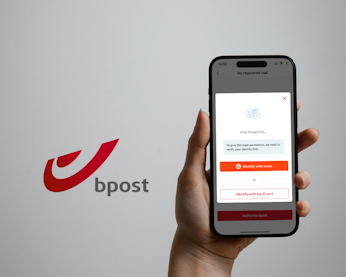
How can postal services grow their revenue in 2026?
Europe’s postal providers are under constant pressure. Traditional mail volumes continue to shrink, parcel margins remain thin, and competition is intensifying—not only from private couriers, but also from global e-commerce giants, such as Amazon and Alibaba, that are moving into delivery. According to McKinsey, these e-commerce players, alongside Chinese e-commerce company JD.com, accounted for around 40% of global online purchases already in 2019. Their move into parcel delivery has put them in direct competition with national postal services in many countries.
Despite this challenging backdrop, European postal players are not without their advantages. They boast their trusted brands, dense networks, and long-standing relationships with both governments and citizens. The question, however, is how to convert those strengths into new, sustainable revenue streams and grow postal revenue in a rapidly evolving market.
This blog explores several concrete opportunities to boost postal revenue, from digital identity and enhanced customer satisfaction to e-government services and smarter e-commerce partnerships.
1. Enhancing customer accessibility offline and online
In a market defined by tight margins and rising customer expectations, postal services need to enhance accessibility and convenience in cost-effective ways. Investing in a flexible, customer-centric postal platform is key to unlocking new postal revenue opportunities. When done well, these improvements foster customer loyalty, trust and retention in an ecosystem crowded with both established players and agile newcomers.
One powerful strategy is for postal players to build on their existing reach with light-touch, customer-facing digital upgrades. Features like mobile apps with real-time delivery updates and QR-code access to parcel lockers are low-investment yet high-impact ways to improve the delivery experience, as we explore below:
A) Boosting engagement and satisfaction through app-based postal services:
La Poste’s Appointment Booking Solution in France enables customers to plan post office visits in advance. This improves the customer experience and helps staff to prepare, manage resources more efficiently, and increase upselling opportunities.
Smarter digital tools are also streamlining back-end processes, for example in managing the complex paperwork required for customs. Bulgaria’s DIGI app offers a secure way for customers to handle customs clearance using their smartphones. By storing personal data securely in the app, repeat senders avoid re-entering the same information, saving time and improving compliance with EU customs rules.
B) Parcel lockers and Pick-Up/Drop-Off points
As consumers increasingly expect free or low-cost shipping, e-retailers and postal operators are expanding their use of parcel lockers and Pick-Up/Drop-Off (PUDO) points to contain last-mile costs. We can expect to see even denser locker networks and greater collaboration across carriers over the coming years.
Omniva is leading the way when it comes to this approach, with a carrier-agnostic, close-to-home locker network in the Baltics. This includes both personal parcel boxes for private residences and shared community lockers. Customers can receive parcels from any carrier, redirect Omniva deliveries automatically, and even access services such as dry cleaning. By using the community locker, they eliminate the need to plan their day around parcel deliveries, drive to collection points, or wait at home for a courier.
The company also deploys mobile parcel trailers—lockers built into trailers—that can be relocated to meet seasonal or event-driven demand. Across the Baltics, Omniva operates over 1,100 parcel machines, providing access to over 150,000 individual lockers.
Another cost-efficient opportunity for postal operators to grow their margins lies in making better use of their physical real estate through smart locker solutions. Omniva, for example, offers the Locker TTW (“Through-the-Wall”), which transforms post offices into 24/7 self-service centres.
These innovations show how postal services can blend digital enhancements with their existing assets to drive satisfaction, retention, and operational resilience without a lot of extra cost.
Unlock the full potential of your operations with digital identity
2. Embracing technology: Cloud, SaaS and AI
Many postal operators still rely on traditional IT systems that are costly to maintain and difficult to scale. Legacy, siloed systems are ill-equipped to keep up with the fast-moving demands of e-commerce and rising customer expectations. Transitioning to scalable, cloud-based postal platforms helps reduce costs and open new avenues for postal revenue.
Cloud and Software-as-a-Service (SaaS): Several postal operators have already embraced cloud technologies to enhance efficiency and reduce costs. For instance, PostNL has implemented a comprehensive cloud strategy, migrating over 30 mission-critical applications to postal platforms like Microsoft Azure and AWS. This transition has enabled PostNL to streamline operations, improve scalability, and achieve significant cost savings by reducing the total cost of ownership of their IT infrastructure.
This shift to the cloud enables new revenue models too. With cloud-based platforms, postal services can offer e-commerce infrastructure-as-a-service—a suite of digital tools and last-mile capabilities bundled together. This could include providing their B2B partners with branded tracking pages, secure delivery confirmation, return logistics, and compliance-ready solutions for age-restricted goods.
The move away from siloed systems also helps postal services integrate fraud prevention and identity verification tools directly into their delivery ecosystems, which are increasingly appealing for e-commerce players. We further explore the value of secure digital identity in the postal sector in the section below.
Customer Identity and Access Management (CIAM) tooling: Such tools focus on how organisations manage, authenticate, and authorise users when they access their digital services. The goal is to improve key customer flows and enhance access management, offering users a more seamless and secure experience.
AI and automation: Postal operators are also turning to AI to automate workflows and reduce costs. In Portugal, CTT has deployed a generative AI assistant named Helena to manage customer support across chat, web, WhatsApp, and Facebook. Able to interact in multiple languages, Helena has reduced call volumes and saved over €10,000 per month in support costs, while improving customer experience.
Swiss Post is using AI and computer vision at its sorting centres to analyse footage from cameras and detect issues like full parcel chutes and alert shift supervisors. Trained on data from key logistics centres, the AI helps reduce manual workload and streamline operations with minimal additional infrastructure.
Automation also helps in streamlining physical logistics. Correos in Spain uses Optical Character Recognition (OCR) to identify incoming parcels faster and more accurately, cutting down on manual errors. In Hungary, Magyar Posta’s SMART by MPL programme manages entire e-commerce fulfilment flows in an automated, robotised warehouse—giving smaller retailers access to enterprise-level logistics as a service.
Read more: itsme® helps bpost to simplify sending and receiving registered mail
3. Harnessing data intelligently
Postal operators are uniquely positioned to leverage vast amounts of operational data, from delivery routes and customer interactions to logistics and inventory management. By adopting data analytics, they can transform this data into actionable insights, leading to enhanced efficiency, cost savings, and improved customer experiences.
Below, we share ways that postal players can generate value from their data:
Replacing silos by unified digital platforms: La Poste Groupe exemplifies the shift towards a data-centric model. By consolidating three legacy systems into a unified digital portal, the organisation has streamlined operations across its postal, banking, and mobile services. Such consolidation enables personalised customer experiences and more efficient service delivery. The projected cost savings of this was €1.7 million by 2024, escalating to €4.3 million by 2025.
Digital twin technology: PostNord’s digital twin technology in Sweden creates virtual models of sorting centres, allowing teams to test scenarios and optimise layouts without disrupting live operations. PostNord has already reported a 6–8% improvement in operational efficiency and a 25% increase in hourly parcel throughput, demonstrating how simulation tools can directly boost performance and resilience.
Leveraging AI to boost operational efficiency: Artificial Intelligence further amplifies these capabilities. La Poste's Optimisation of Resources (POP IA) tool aids managers in creating optimised schedules and adapting to organisational changes with AI-driven simulations. Route optimisation is another area where data and AI converge to deliver tangible benefits. DHL's Greenplan algorithm, for example, leverages real-time data to create efficient delivery routes, significantly reducing delivery times and fuel consumption. Such tools not only enhance operational efficiency but also contribute to environmental sustainability by lowering emissions.
By harnessing data insights, postal operators can navigate the complexities of modern logistics, drive innovation, and maintain a competitive edge in an evolving market landscape.
4. Utilising verified digital identity
In 2025, trusted digital identity platforms are emerging as pivotal tools for postal operators to streamline operations, bolster security, offer value-added services, and enhance customer experiences.
For example, Finland's Posti leverages the Finnish Trust Network (FTN), an authentication method that aggregates various strong authentication methods like bank credentials and mobile certificates. This integration allows customers to perform sensitive tasks, such as redirecting mail or authorising someone to pick up a parcel, entirely online. This ensures and simplifies compliance with GDPR and national regulations.
France’s La Poste Groupe's digital subsidiary, Docaposte, has developed ID360 , a comprehensive remote identity verification platform designed to meet the diverse needs of various sectors, including postal services. ID360 enables postal operators to offer secure and efficient services such as remote customer onboarding, electronic signatures, and verified logins for financial services, e-commerce, and government interactions. By integrating ID360, postal services can facilitate sensitive operations like mail forwarding, electronic registered mail, and parcel collection from post offices or lockers without requiring in-person verification. This also streamlines internal processes, allowing for scalable and compliant digital transformations across the postal sector.
In the UK, Post Office’s EasyID app enables users to create a secure digital identity by scanning a government-issued ID and capturing a biometric selfie, which is then stored on their smartphone. This digital ID can be used to prove identity or age both online and in person, streamlining tasks such as parcel collection, eliminating the need for physical documents, and reducing wait times in branches.
Fortunately, postal operators aiming to enhance their digital identity capabilities don't necessarily need to develop proprietary systems from the ground up. Instead, they can integrate established digital identity solutions, leveraging their existing users’ trust. A prime example is digital identity platform itsme®, which provides postal players with a secure way to conduct digital identity verification, passwordless authentication, qualified e-signature, and data sharing capabilities.
Belgium's bpost leverages itsme® within its postal platform to enable users to digitally access services like receiving registered mail. This integration not only simplifies the user experience, but also maintains the legal validity of registered mail. As a result, bpost has seen higher delivery success rates and reduced in-person visits to postal offices, directly boosting postal revenue while meeting customer expectations.
Curious about the possibilities of verified digital identity? Click here to learn more
